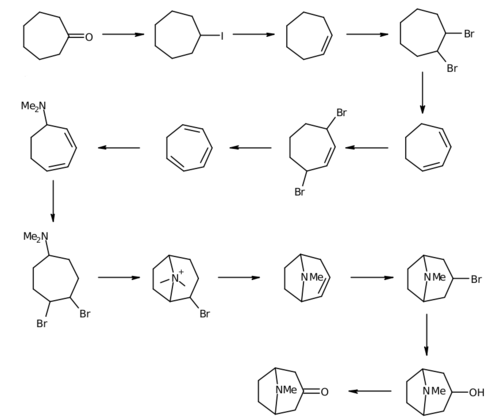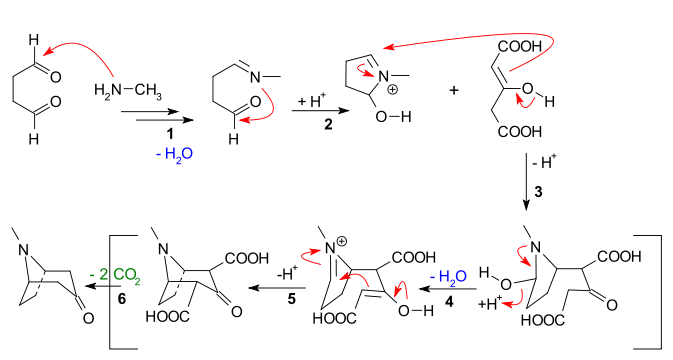
Tropinone
Encyclopedia
Tropinone is an alkaloid
, famously synthesised in 1917 by Robert Robinson as a synthetic
precursor to atropine
, a scarce commodity during World War I
. Tropinone and the alkaloids cocaine
and atropine all share the same tropane
core structure.
in 1901. It started from the seemingly related cycloheptanone
, but required many steps to introduce the nitrogen bridge; the overall yield
for the synthesis path is only 0.75%. Willstätter had previously synthesized cocaine from tropinone, in what was the first synthesis and elucidation of the structure of cocaine.

The 1917 synthesis by Robinson is considered a classic in total synthesis
due to its simplicity and biomimetic approach. Tropinone is a bicyclic molecule
, but the reactants used in its preparation are fairly simple: succinaldehyde, methylamine
and acetonedicarboxylic acid
(or even acetone
). The synthesis is a good example of a biomimetic reaction or biogenetic-type synthesis because biosynthesis
makes use of the same building blocks. It also demonstrates a tandem reaction in a one-pot synthesis
. Furthermore the yield of the synthesis was 17% and with subsequent improvements exceeded 90%.
This reaction is described as an intramolecular "double Mannich reaction
" for obvious reasons. It is not unique in this regard, as others have also attempted it in piperidine synthesis.
In place of acetone, acetonedicarboxylic acid is known as the "synthetic equivalent" the 1,3-dicarboxylic acid groups are so-called "activating group
s" to facilitate the ring forming reactions. The calcium salt is there as a "buffer
" as it is claimed that higher yields are possible if the reaction is conducted at "physiological pH
".
Some authors have actually tried to retain one of the CO2H groups.
CO2R-tropinone has 4 stereoisomers, although the corresponding ecgonidine
alkyl ester there is only a pair of enantiomers.
Alkaloid
Alkaloids are a group of naturally occurring chemical compounds that contain mostly basic nitrogen atoms. This group also includes some related compounds with neutral and even weakly acidic properties. Also some synthetic compounds of similar structure are attributed to alkaloids...
, famously synthesised in 1917 by Robert Robinson as a synthetic
Organic chemistry
Organic chemistry is a subdiscipline within chemistry involving the scientific study of the structure, properties, composition, reactions, and preparation of carbon-based compounds, hydrocarbons, and their derivatives...
precursor to atropine
Atropine
Atropine is a naturally occurring tropane alkaloid extracted from deadly nightshade , Jimson weed , mandrake and other plants of the family Solanaceae. It is a secondary metabolite of these plants and serves as a drug with a wide variety of effects...
, a scarce commodity during World War I
World War I
World War I , which was predominantly called the World War or the Great War from its occurrence until 1939, and the First World War or World War I thereafter, was a major war centred in Europe that began on 28 July 1914 and lasted until 11 November 1918...
. Tropinone and the alkaloids cocaine
Cocaine
Cocaine is a crystalline tropane alkaloid that is obtained from the leaves of the coca plant. The name comes from "coca" in addition to the alkaloid suffix -ine, forming cocaine. It is a stimulant of the central nervous system, an appetite suppressant, and a topical anesthetic...
and atropine all share the same tropane
Tropane
Tropane is a nitrogenous bicyclic organic compound. It is mainly known for a group of alkaloids derived from it , which include, among others, atropine and cocaine. Both alkaloids contain tropinone from which tropane is a derivate...
core structure.
Synthesis
The first synthesis of tropinone was by Richard WillstätterRichard Willstätter
Richard Martin Willstätter was a German organic chemist whose study of the structure of plant pigments, chlorophyll included, won him the 1915 Nobel Prize for Chemistry. Willstätter invented paper chromatography independently of Mikhail Tsvet.-Biography:Willstätter was born in to a Jewish family...
in 1901. It started from the seemingly related cycloheptanone
Cycloheptanone
Cycloheptanone, 6CO, is a cyclic ketone also referred to as suberone. It is a colourless volatile liquid. Cycloheptanone is used as a precursor for the synthesis of pharmaceuticals.- Synthesis :...
, but required many steps to introduce the nitrogen bridge; the overall yield
Yield (chemistry)
In chemistry, yield, also referred to as chemical yield and reaction yield, is the amount of product obtained in a chemical reaction. The absolute yield can be given as the weight in grams or in moles...
for the synthesis path is only 0.75%. Willstätter had previously synthesized cocaine from tropinone, in what was the first synthesis and elucidation of the structure of cocaine.

The 1917 synthesis by Robinson is considered a classic in total synthesis
Total synthesis
In organic chemistry, a total synthesis is, in principle, the complete chemical synthesis of complex organic molecules from simpler pieces, usually without the aid of biological processes. In practice, these simpler pieces are commercially available in bulk and semi-bulk quantities, and are often...
due to its simplicity and biomimetic approach. Tropinone is a bicyclic molecule
Bicyclic molecule
A bicyclic molecule is a molecule that features two fused rings. Bicyclic molecules occur widely in organic and inorganic compounds.Fusion of the rings can occur in three ways:...
, but the reactants used in its preparation are fairly simple: succinaldehyde, methylamine
Methylamine
Methylamine is the organic compound with a formula of CH3NH2. This colourless gas is a derivative of ammonia, but with one H atom replaced by a methyl group. It is the simplest primary amine. It is sold as a solution in methanol, ethanol, THF, and water, or as the anhydrous gas in pressurized...
and acetonedicarboxylic acid
Acetonedicarboxylic acid
Acetonedicarboxylic acid or 3-oxoglutaric acid is a simple carboxylic acid, which may be used as a building block in organic chemistry....
(or even acetone
Acetone
Acetone is the organic compound with the formula 2CO, a colorless, mobile, flammable liquid, the simplest example of the ketones.Acetone is miscible with water and serves as an important solvent in its own right, typically as the solvent of choice for cleaning purposes in the laboratory...
). The synthesis is a good example of a biomimetic reaction or biogenetic-type synthesis because biosynthesis
Biosynthesis
Biosynthesis is an enzyme-catalyzed process in cells of living organisms by which substrates are converted to more complex products. The biosynthesis process often consists of several enzymatic steps in which the product of one step is used as substrate in the following step...
makes use of the same building blocks. It also demonstrates a tandem reaction in a one-pot synthesis
One-pot synthesis
In chemistry a one-pot synthesis is a strategy to improve the efficiency of a chemical reaction whereby a reactant is subjected to successive chemical reactions in just one reactor...
. Furthermore the yield of the synthesis was 17% and with subsequent improvements exceeded 90%.
This reaction is described as an intramolecular "double Mannich reaction
Mannich reaction
The Mannich reaction is an organic reaction which consists of an amino alkylation of an acidic proton placed next to a carbonyl functional group with formaldehyde and ammonia or any primary or secondary amine. The final product is a β-amino-carbonyl compound also known as a Mannich base...
" for obvious reasons. It is not unique in this regard, as others have also attempted it in piperidine synthesis.
In place of acetone, acetonedicarboxylic acid is known as the "synthetic equivalent" the 1,3-dicarboxylic acid groups are so-called "activating group
Activating group
In organic chemistry, a functional group is called an activating group if a benzene molecule to which it is attached more readily participates in electrophilic substitution reactions...
s" to facilitate the ring forming reactions. The calcium salt is there as a "buffer
Buffer solution
A buffer solution is an aqueous solution consisting of a mixture of a weak acid and its conjugate base or a weak base and its conjugate acid. It has the property that the pH of the solution changes very little when a small amount of strong acid or base is added to it. Buffer solutions are used as a...
" as it is claimed that higher yields are possible if the reaction is conducted at "physiological pH
PH
In chemistry, pH is a measure of the acidity or basicity of an aqueous solution. Pure water is said to be neutral, with a pH close to 7.0 at . Solutions with a pH less than 7 are said to be acidic and solutions with a pH greater than 7 are basic or alkaline...
".
Reaction mechanism
The main features apparent from the reaction sequence below are:- Nucleophilic additionNucleophilic additionIn organic chemistry, a nucleophilic addition reaction is an addition reaction where in a chemical compound a π bond is removed by the creation of two new covalent bonds by the addition of a nucleophile....
of methylamineMethylamineMethylamine is the organic compound with a formula of CH3NH2. This colourless gas is a derivative of ammonia, but with one H atom replaced by a methyl group. It is the simplest primary amine. It is sold as a solution in methanol, ethanol, THF, and water, or as the anhydrous gas in pressurized...
to succinaldehyde, followed by loss of water to create an imineImineAn imine is a functional group or chemical compound containing a carbon–nitrogen double bond, with the nitrogen attached to a hydrogen atom or an organic group. If this group is not a hydrogen atom, then the compound is known as a Schiff base... - Intramolecular addition of the imine to the second aldehyde unit and first ring closure
- Intermolecular Mannich reactionMannich reactionThe Mannich reaction is an organic reaction which consists of an amino alkylation of an acidic proton placed next to a carbonyl functional group with formaldehyde and ammonia or any primary or secondary amine. The final product is a β-amino-carbonyl compound also known as a Mannich base...
of the enolate of acetone dicarboxylate - New enolate formation and new imine formation with loss of water for
- Second intramolecularIntramolecularIntramolecular in chemistry describes a process or characteristic limited within the structure of a single molecule, a property or phenomenon limited to the extent of a single molecule.- Examples :...
mannich reaction and second ring closure - Loss of 2 carboxylic groups to tropinone
Some authors have actually tried to retain one of the CO2H groups.
CO2R-tropinone has 4 stereoisomers, although the corresponding ecgonidine
Ecgonidine
Ecgonidine is an alkaloid related to ecgonine and cocaine. It has a structure with a cycloheptene ring, with a nitrogen bridge, and a carboxylic acid side chain....
alkyl ester there is only a pair of enantiomers.



